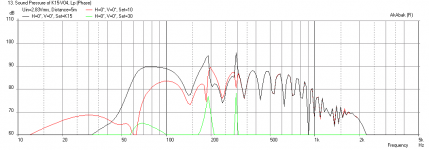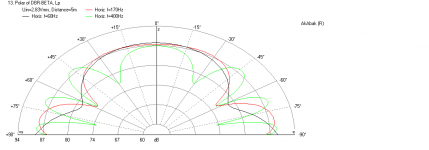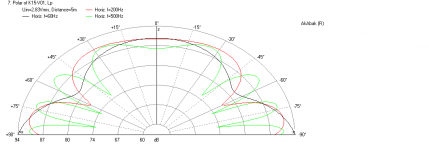at times I'm lazy and grab an Eminence 1K6 textbook value crossover - sometimes that sums ok, other times its not so good. For a 12" coupler a Kappa12A would hold down a lot of power at a reasonable cost. The little "X15" and its spinoffs (Transylvania Power, Westwood, Acoustic Control, KK-Audio) were only about a cubic foot or so larger in bulk than Karlson's K12 .
I have a 12PE32 in a slit vent K12
Eminence developed a new generic 2K5 network for their CX which seems to work well - IIRC the values =
lowpass = 2mH/10uF
highpass = 3.3uF/0.35mH
B&C 12PE32 12" Midbass Speaker 294-660
Eminence Kappa-12A 12" Driver 8 Ohm 290-456
I have a 12PE32 in a slit vent K12
Eminence developed a new generic 2K5 network for their CX which seems to work well - IIRC the values =
lowpass = 2mH/10uF
highpass = 3.3uF/0.35mH
B&C 12PE32 12" Midbass Speaker 294-660
Eminence Kappa-12A 12" Driver 8 Ohm 290-456
Last edited:
Gary Chemelec scaled K15 by ~0.75 to give about the same package as the factory K12. When making "X12" with an internal tube, the front shelf would have to be deleted. A 1"ID by 7" long tube would fit on the "1958 style" (probably 1956) K12 port panel after the vents are moved. That would keep things compact and the tube safe.
Gary's scaled K12
Gary's scaled K12
An externally hosted image should be here but it was not working when we last tested it.
what the Karlson kommunity is hoping from the akabak modeling is to see if there are benefits from pulling in coupler width and making them taller - sometimes to flatten a rise around 200, other times to extend the front coupler's contribution.
here's my tallest K at ~41" height, by 22.5" wide by 16" deep built for me by John Lapaire - it has usually run an internal X15 size K-tube and sounded very good on a variety of genre including rap and opera. It can hit hard with very little cone excursion and of course murder a bass reflex for output vs cone excursion. Its run 18" with moving mass from 70 grams (EVM18) to an Electar made by Eminence with 130 grams mms.
here's my tallest K at ~41" height, by 22.5" wide by 16" deep built for me by John Lapaire - it has usually run an internal X15 size K-tube and sounded very good on a variety of genre including rap and opera. It can hit hard with very little cone excursion and of course murder a bass reflex for output vs cone excursion. Its run 18" with moving mass from 70 grams (EVM18) to an Electar made by Eminence with 130 grams mms.
An externally hosted image should be here but it was not working when we last tested it.
An externally hosted image should be here but it was not working when we last tested it.
My Akabak model has independent height vs width and depth scaling so I can stretch the box in one dimension only and shrink in another to preserve volume. I also have the Karlson aperture as a quadratic curve fit that can scale in length and width as it is a normalized zero to unity function as the basis function. From there I can apply scaling for the large opening, and the gap can be adjusted with an offset constant. I have already shown that stretching the K15 box by factor of 19/15 improves the bass on the Betsy. Although in that case I actually increased the width and depth by a factor of 16/15 as it seems that the Betsy K had a rather large Qts that benefitted from a lot of extra volume. Is there a K aperture function other than the prescribed table from the 1954 design that I should try? My guess is that it will have little noticeable effect as I saw hardly any difference going from 9 aperture to 14 aperture approximation of the K aperture.
K-builder Carl uses a variety of curves when developing a coupler - - by the formula below, John Karlson used P=1/Q=1.7 for the X15 cabinet and it opened a bit faster than a radial arc. A tighter expansion Carl tests is P=1/Q= 3 and that may possibly lower the system tuning and cutoff in some K-couplers. Also Keh Lehman had a spreadsheet for trax curves which produced results Carl liked.
10 CLS
15 Pr_int "Two Variable K-slot Calculator"
20 Pr_int "P=1, Q=1.7=Radial, P=1, Q=3 modified exponential"
30 Input "Enter P=> 1 and
40 Input "Enter Q between 1.7 and 4";Q
50 Input "Enter Slot Length";L
60 Input "Enter 1/2 initial slot width 't' ";T
70 Input "Enter 1/2 final slot width 'w' ";W
80 Input "Enter desired step increment";Z
85 B=(W-T)/(L^Q-Q/P*L^P)
90 A=(Q/P)*B
100 Y=T-A*X^P+B*X^Q
110 IF LC> 22 TH_EN LC=0:Input "Press Enter for next page";W$
120 X=X+Z
122 Pr_int "X=";X-Z, "Y=";Y
125 LC=LC+1
1-3-0 I-F X lessthan L+Z then go-to 100 e-l-s-e e-n-d
the plan below is kinda the way Carl builds some tall K's - the aperture be extended to the top with a narrow inverted "V" to add air to the sound
Picasa Web Albums - greg muon - STUPID HIFI T...
here's one of Carl's test-K's - note the K-tube
10 CLS
15 Pr_int "Two Variable K-slot Calculator"
20 Pr_int "P=1, Q=1.7=Radial, P=1, Q=3 modified exponential"
30 Input "Enter P=> 1 and
40 Input "Enter Q between 1.7 and 4";Q
50 Input "Enter Slot Length";L
60 Input "Enter 1/2 initial slot width 't' ";T
70 Input "Enter 1/2 final slot width 'w' ";W
80 Input "Enter desired step increment";Z
85 B=(W-T)/(L^Q-Q/P*L^P)
90 A=(Q/P)*B
100 Y=T-A*X^P+B*X^Q
110 IF LC> 22 TH_EN LC=0:Input "Press Enter for next page";W$
120 X=X+Z
122 Pr_int "X=";X-Z, "Y=";Y
125 LC=LC+1
1-3-0 I-F X lessthan L+Z then go-to 100 e-l-s-e e-n-d
the plan below is kinda the way Carl builds some tall K's - the aperture be extended to the top with a narrow inverted "V" to add air to the sound
Picasa Web Albums - greg muon - STUPID HIFI T...
here's one of Carl's test-K's - note the K-tube
Last edited:
regarding akabak, what do you see in the Karlson horizontal dispersion vs a direct radiator? Carl says K's not only disperse but don't have dead spots on stage like reflex.
The K-aperture certainly does provide improved dispersion. To show the difference, I simulated a straight bass reflex cabinet for a Betsy K and plot the polar SPL at 5 m for 60 Hz, 170 Hz, 400 Hz (selected to capture most uniform frequencies at these 3 ranges. As expected, the lower frequencues 60 and 170 Hz are very uniform and omnidirectional as expected. At 400 Hz though, lobing can be seen and the central lobe is good for a 30 deg cone (+/- 15 deg). Next is a Betsy K in a K15 (1954 with 30.5 sq in vent) at similar frequencies (60 Hz, 200 Hz, 500 Hz). Here you can see that the Karlson aperture produces central lobe that is about 70 deg wide (+/- 35 deg). Obviously, 75 deg is a lot better than 30 deg. I wouldn't say that there aren't any dead spots as you go past 45 deg off axis there are several lobes that will appear to have dead spots at 500 Hz. The same is true with the bass reflex with direct radiator, but it happens at a much smaller off-axis angle. BTW, the 70 deg dispersion uniformity is perfect to couple this with a compression driver fitted with a standard 60 deg wide horn (the kind that fits inside a coaxial driver like the Beta C10X).
So, another reason why the Karlson kicks butt in larger spaces.
Attachments
Last edited:
Carl Neuser of MI - appeared briefly on Job Ulfman's K-forum then the late Gregg Baker's K-forum. Carl and his son have worked with K's for many years. Carl is an engineer - probably about 10 years older than myself making him in early 70's - pm me and I can give you his email
a few years ago I made a one-sheet tapped TL pipe woofer in a style suggested by "nineleaves" - - its about the same overall bulk of K15 but goes lower with f3 of 40 and f10 and fb of 30 What might be done with it to lessen its 120Hz null? as is it might make a helper woofer for something and hornresp seemed able to model it well. In play and testing its mouth was kept at the floor boundary.
7.4 cubic foot inverted tapped horn/transflex-type test pipe from 1 sheet of plywood - YouTube
7.4 cubic foot inverted tapped horn/transflex-type test pipe from 1 sheet of plywood - YouTube
Last edited:
Doc,
I would be interested to see your sims of a K5. My AkAbak model shows that the Karlson cabinet and its variants scale very poorly below a 12/15 ratio from the K15. Perhaps the SK8 with curved reflector fares better but if general shape of front and back chamber connected by vent with K Aperture on front, that design does not work below 12/15 or 80% scaling of original K15.
I would be interested to see your sims of a K5. My AkAbak model shows that the Karlson cabinet and its variants scale very poorly below a 12/15 ratio from the K15. Perhaps the SK8 with curved reflector fares better but if general shape of front and back chamber connected by vent with K Aperture on front, that design does not work below 12/15 or 80% scaling of original K15.
I'm simming it as a series tuned bandpass. The back chamber is 4 liters and tuned to 100 Hz and the front chamber is 2 liters and resonates around 500 Hz. although not the most ideal way to sim it it does predict the bass response. I don't expect much bass. 80 Hz seems to be as low as it wants to go.
my best success with small drivers came with K-Lines where the line was a 14 wave length of the driver Fs. With K-Lines I got the most consistent results with the line coupling to the front chamber at the top front. so the 1/4 wave was comprised of the total distance from the back side of the driver to the front side of the driver. Best regards Moray James
The one K5 design I played with had no bass, response fell under ~150-200Hz. It makes sense as the 2x sized SK8 (K10 actually) does 75-80Hz itself. A mini K-line will likely be of larger bulk, but should perform better.
Doc, what's that little Klam-looking box in your avatar picture?
IG
Doc, what's that little Klam-looking box in your avatar picture?
IG
Thats my vented micro Klam that I'm currently experimenting with. I currently have a Tang Band w3-315 in it.
Nice, it looks cool. I have yet to try a Klam myself. It's more likely to succeed than a scaled-down K4 or K5 IMO. Does your vent terminate in the Klam-chamber?
IG
I'm actually thinking that Klams will work better for smaller drivers. Yes it vents into the front chamber. Right now I have 2 half inch ports but I'm getting the best results from having one of them plugged. I will try more vent combinations when I get the time to. I want to see if making the ports longer has any effect. I'm getting a response down to 120 Hz
I'm actually thinking that Klams will work better for smaller drivers. Yes it vents into the front chamber. Right now I have 2 half inch ports but I'm getting the best results from having one of them plugged. I will try more vent combinations when I get the time to. I want to see if making the ports longer has any effect. I'm getting a response down to 120 Hz
My guess is the standard Helmholtz equations apply, save for a bit of loading from the Klam-chamber's air mass, making for a tuning slightly lower than predicted. It might be fun to make small desktop Klams with stand, where the stand is also the vent, like Fostex did on an enclosure for FE166 or 167. This allows for a fairly large and long vent that would otherwise not fit into a small Vb. Maybe I should build that one for FF85WK.
IG
- Home
- Loudspeakers
- Full Range
- Karlson


